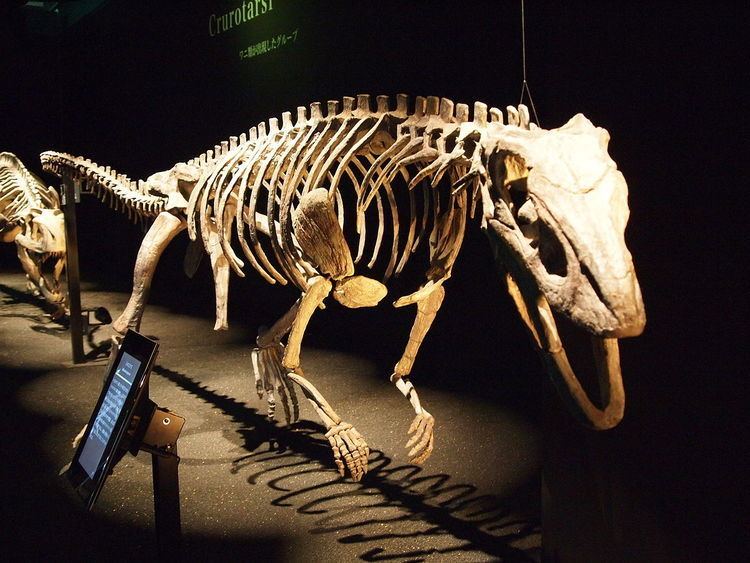Kingdom Animalia Class Reptilia Rank Superfamily | Phylum Chordata Clade Paracrocodylomorpha | |
 | ||
Branch †Poposauroidea
Nopsca, 1923 Similar Poposaurus, Ctenosauriscidae, Sillosuchus, Ctenosauriscus, Shuvosaurus | ||
Poposauroidea is a clade of paracrocodylomorpha. It includes poposaurids, shuvosaurids, and ctenosauriscids, but excludes the large predatory quadrupedal rauisuchians such as rauisuchids and prestosuchids. Although it was first formally defined in 2007, the term has been used for many years. The group has been referred to as Poposauridae by some authors, although this name is often used more narrowly to refer to the family that includes Poposaurus and its close relatives.
History
Franz Nopcsa first used the term Poposauridae in 1923 to refer to poposauroids. At this time, the sole member of the group was Poposaurus, which was considered to be a theropod dinosaur. Over the following years, poposauroids were placed in various groups, including Saurischia, Theropoda, and Carnosauria. This classification existed up until the 1970s, when better remains indicated that Poposaurus was a crurotarsan rather than a dinosaur. Other genera such as Sillosuchus and Shuvosaurus were later erected. Like Poposaurus, Shuvosaurus was originally thought to be a theropod dinosaur.
Sankar Chatterjee reclassified poposauroids as theropod dinosaurs with his description of the new genus Postosuchus in 1985. Chaterjee even considered poposauroids to be the ancestors of tyrannosaurs. Postosuchus was widely considered to be a poposauroid for the next ten years and was included in many phylogenetic analyses of Triassic archosaurs. In 1995, Robert Long and Phillip A Murry showed that the original material of Postosuchus was a chimera (paleontology), or collection of bones from several different animals. According to Long and Murry, Chaterjee's Postosuchus material included bones of Poposaurus and Shuvosaurus, giving the impression that it was a poposauroid. Postosuchus has since been classified as a rauisuchid, and poposauroids are generally considered not to be theropod dinosaurs.
Poposauroidea was formally defined as a clade by Jonathan C. Weinbaum and Axel Hungerbühler in 2007. In their paper, Weinbaum and Hungerbühler described two new skeletons of Poposaurus and incorporated several new characters of the genus into a phylogenetic analysis. Poposauroidea was recovered as a monophyletic grouping, while other rauisuchians (namely Rauisuchidae and Prestosuchidae) were placed as basal forms of a new group called Paracrocodyliformes.
In 2005, paleontologist Paul Sereno defined Poposauridae as a stem-based taxon that includes all taxa more closely related to Poposaurus gracilis than to Crocodylus niloticus, the Nile crocodile. This would encompass not just poposaurids like Poposaurus but also many other poposauroids, making it equivalent to Poposauroidea in Weinbaum and Hungerbühler's study.
Brusatte et al. (2010) conducted a phylogenetic study of archosaurs that resulted in a grouping referred to as Poposauroidea. Unlike many recent studies, they found Rauisuchia to be monophyletic, consisting of two major clades: Rauisuchoidea and Poposauroidea. However, the monophyly of Rauisuchia was not strongly supported in Brutasse et al.'s analysis. They noted that if their tree was enlarged by one step, Poposauroidea fell outside Rauisuchia to become the sister group of Ornithosuchidae, which is thought to closely related to, but outside, Rauisuchia. In their tree, Poposauroidea included genera usually classified as poposauroids as well as several other genera that are not traditionally placed in the group. One genus, Yarasuchus, was previously classified as a prestosuchid, but was found to be the most basal poposauroid. Yarasuchus is unusual in that it has a relatively long neck and small size. The other genus, Qianosuchus, is unique among crurotarsans in its semiaquatic lifestyle.
In his massive revision of archosaurs which included a large cladistic analysis, Sterling J. Nesbitt (2011) found Xilousuchus to be a poposauroid most closely related to Arizonasaurus. Nesbitt's analysis did not recover a monophyletic Rauisuchia or monophyletic Rauisuchoidea. Poposauroidea was found to be monophyletic, and more resolved than in previous analyses. The cladogram below follows Nesbitt (2011) with clade names based on previous studies.
